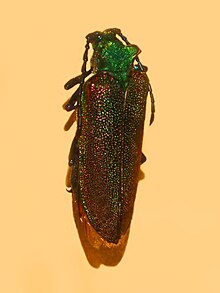
The insects of the beetle family Chrysomelidae are commonly known as leaf beetles, and include over 37,000 species in more than 2,500 genera, making up one of the largest and most commonly encountered of all beetle families. Numerous subfamilies are recognized, but the precise taxonomy and systematics are likely to change with ongoing research.

The longhorn beetles (Cerambycidae), also known as long-horned or longicorns, are a large family of beetles, with over 35,000 species described. Most species are characterized by extremely long antennae, which are often as long as or longer than the beetle's body. In various members of the family, however, the antennae are quite short and such species can be difficult to distinguish from related beetle families such as the Chrysomelidae. The scientific name of this beetle family goes back to a figure from Greek mythology: after an argument with nymphs, the shepherd Cerambus was transformed into a large beetle with horns.

Histeridae is a family of beetles commonly known as clown beetles or Hister beetles. This very diverse group of beetles contains 3,900 species found worldwide. They can be easily identified by their shortened elytra that leaves two of the seven tergites exposed, and their geniculate (elbowed) antennae with clubbed ends. These predatory feeders are most active at night and will fake death if they feel threatened. This family of beetles will occupy almost any kind of niche throughout the world. Hister beetles have proved useful during forensic investigations to help in time of death estimation. Also, certain species are used in the control of livestock pests that infest dung and to control houseflies. Because they are predacious and will even eat other Hister beetles, they must be isolated when collected.

The musk beetle is a Eurasian species of longhorn beetle belonging to the subfamily Cerambycinae, tribe Callichromatini. Its name comes from the delicate musky smell it emits when menaced.

The family Oedemeridae is a cosmopolitan group of beetles commonly known as false blister beetles, though some recent authors have coined the name pollen-feeding beetles. There are some 100 genera and 1,500 species in the family, mostly associated with rotting wood as larvae, though adults are quite common on flowers. The family was erected by Pierre André Latreille in 1810.
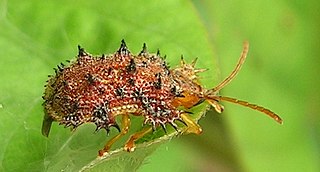
The Cassidinae are a subfamily of the leaf beetles, or Chrysomelidae. The antennae arise close to each other and some members have the pronotal and elytral edges extended to the side and covering the legs so as to give them the common name of tortoise beetles. Some members, such as in the tribe Hispini, are notable for the spiny outgrowths to the pronotum and elytra.
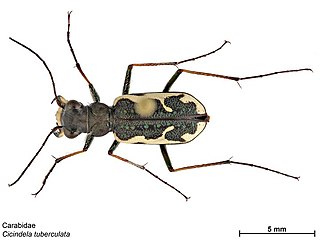
Neocicindela tuberculata is a species of tiger beetle in the subfamily Cicindelinae of the family Carabidae, endemic to New Zealand. Its common names include common tiger beetle, moeone, and papapa, and in its laval stage penny doctor, butcher boy, kapuku, kui, kurikuri, moeone, and muremure. Neocicindela tuberculata was the first carabid beetle described from New Zealand. The species can run as fast as 5 miles per hour and are considered to be the fastest running beetles. Adult species prefer clay banks in summer and are good predators when in comes to insects.

The Disteniidae are a small family of beetles in the superfamily Chrysomeloidea, traditionally treated as a group within the Cerambycidae.

The Oxypeltidae are a small family belonging to the superfamily Chrysomeloidea, widespread in the Andean region of Chile and Argentina. They have traditionally been considered a group within the Cerambycidae.

Eupholus geoffroyi is a species of beetle belonging to the family Curculionidae.

Eupholus schoenherri is a species of beetle belonging to the family Curculionidae. Eupholus petitii is sometimes included here as a subspecies.

Zographus regalis is a species of beetle belonging to the family Cerambycidae.

Sternotomis pulchra is a species of beetle belonging to the family Cerambycidae.
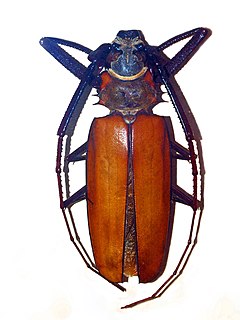
Enoplocerus armillatus, common name giant longhorn beetle or imperious sawyer, is a species of longhorn beetle in the subfamily Prioninae of the family Cerambycidae.

Trictenotoma childreni, the log-boring beetle or brown steampunk beetle, is a species of beetle in the Trictenotomidae family. It can reach a body length of about 55–65 mm (2.2–2.6 in). Basic color of these large beetles is black, the body is slightly flattened. The elytra and the body are covered with thick grayish-yellow hair that fluoresce under ultraviolet light. It has large eyes, long antennae and legs, and powerful mandibles. This species can be found in Malaysia, Myanmar, Borneo, Thailand, Indonesia, Vietnam, China, and India in damp and seasonal forests.

Chalcophora virginiensis, the sculptured pine borer, is a metallic woodboring beetle of the Buprestidae family. It is endemic to forested areas in the eastern United States and Canada. Some authors have synonymised it with the western species Chalcophora angulicollis, but Maier and Ivie (2013) demonstrate that the species are distinct.
Parmenolamia unifasciata is a species of beetle in the family Cerambycidae, and the only species in the genus Parmenolamia. It was described by Stephan von Breuning in 1950, from a specimen collected in Quang Tre Vietnam.
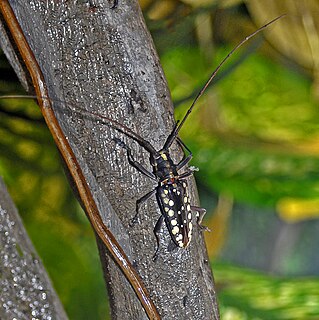
Taeniotes farinosus is a species of beetle in the family Cerambycidae. It was described by Carl Linnaeus in 1758, originally under the genus Cerambyx.
Chrysanthia superba is a species of false blister beetles belonging to the family Oedemeridae.
Zoodes maculatus is a species of Longhorn beetle native to Sri Lanka and India.
